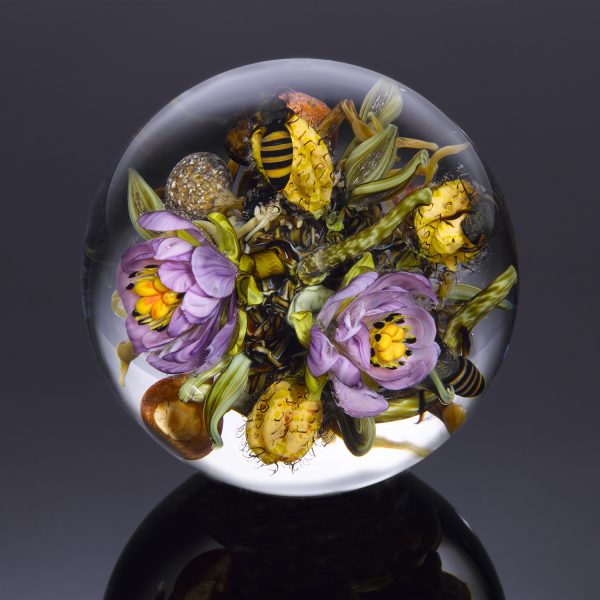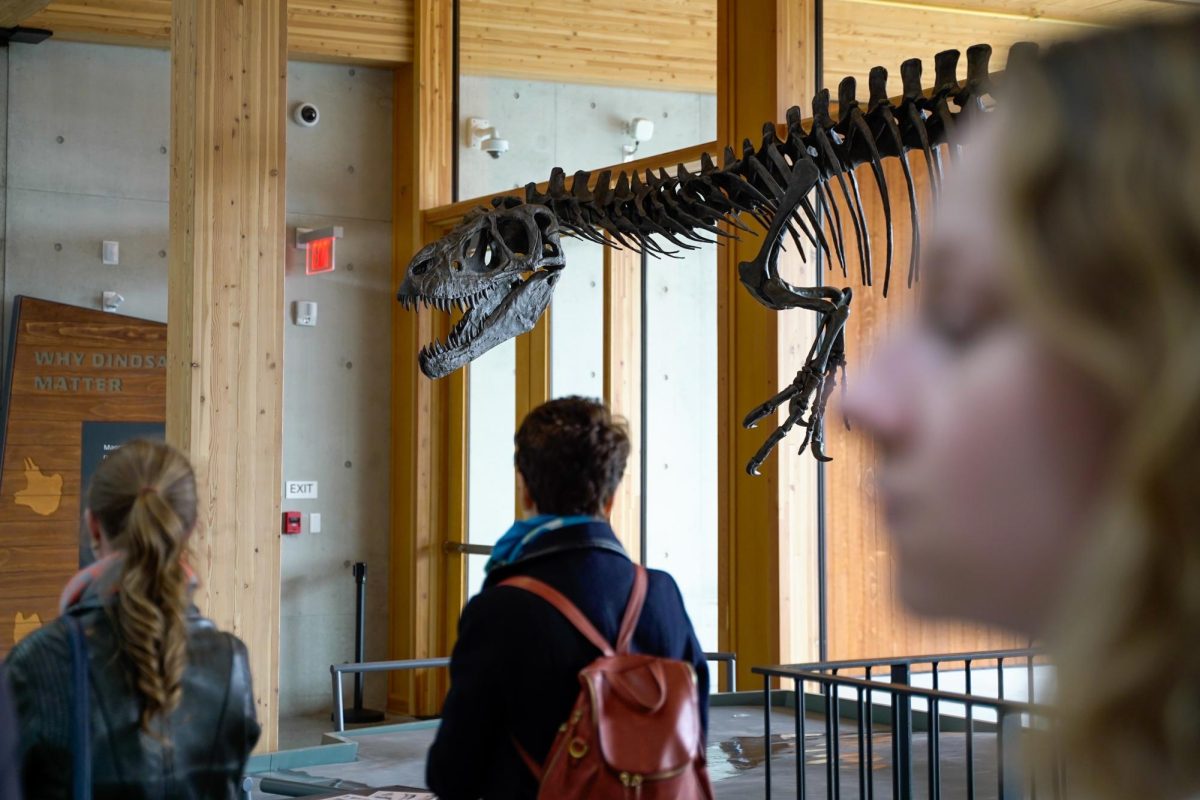Down a narrow, tree-lined road in Mantua, New Jersey, through an opening in a short, stone wall and down a curved brick walkway, the workshop of a world famous glass artist sits unassumingly.
Paul Stankard has been working with glass for over six decades now, originally starting out in scientific glass at Salem County Vocational School at the suggestion and prompting of his father.
“I was a poor student because of undiagnosed dyslexia. And so I came home and my dad was at the dinner table… ‘Papa, I’m thinking about being a machinist….’ He said, ‘That’s a good trade, son.’ He opened it up, ‘Glass blowing, scientific glass blowing. That’s what you should be,’” said Stankard of his father’s influence on his career path.
Since then, Stankard has received numerous awards for his intricate and creative work in glass, most recently the Masters of the Medium Award from Smithsonian’s The James Renwick Alliance, Glass Art Society’s Lifetime Achievement Award, and American Craft Council College of Fellows, according to his website. He also has been awarded two honorary doctorate degrees, one honorary associate’s degree, and is an Artist-in-Resident and Honorary Professor at Salem Community College.

Stankard’s evolution into creative, nature-inspired work
After initially working in scientific glass for about a decade, Stankard transitioned to the more artistic area of glasswork, having always wanted to be involved in the creative process.
“When I was at school, when I would have had extra time, I’d make a little animal or something, give it to Pat [his wife] or give it to my mom,” he said. “And even when I worked in industry at lunchtime, I could play with the glass a little bit.”
In his years of work, Stankard has become known throughout the world for his creations, small sculptures, and paperweights that are heavily inspired by nature. Every component of Stankard’s works is made of glass, though not everyone realizes that upon first seeing his pieces.
“Sometimes they feel a little self-conscious, ‘Oh, I’m sorry. I should have known.’ No, it’s a wonderful compliment to me,” said Stankard.
His work features flowers, fruits, plants, bees and other animals, masks or faces, and small human figures that are arranged and then suspended in glass, usually either in a spherical or cubic shape.

“Initially, I was making animal motifs… And then out of the blue, one day, I made a daisy, and I encapsulated it into a small paperweight. And when it came out of the oven. I said, ‘Oh, wow, that’s so interesting. Is that a real daisy?’” he said. “With the animal motifs, you knew it was just a design. So I got so excited about the daisy. I stopped making the animals because I was experimenting… I put a stem on and leaves, and then the next one had buds… It really captured my attention. And then from the daisies, it went to other flowers.”
The inside of his Mantua, N.J.-based workshop is sectioned off into multiple rooms. An office area is on the top most level and below that is the workbench where Stankard does the most detailed aspects of his work. The ground level is where the glass ovens, materials for the encapsulation of the pieces into spheres and cubes, and the glass itself is stored. The glass is consumer-grade colored glass from Germany.
The ornate details of Stankard’s works are made by Stankard sitting behind his workbench and using a torch to make the smaller pieces, then putting them in an oven designed for glass creations to set, then all of the pieces are arranged and encapsulated in molten, clear glass.
To labor is to pray
From the layout of his studio alone, Stankard’s dedication to his craft is clear. A separate building on his property leading back to his house with a stone path, the door opens up to a big open, naturally lit space. Oxygen tanks and propane sit to the right of the doorway and Stankard’s mottos, “Laborare est orare” and “Memento mori” sit facing the door, translating loosely to “To work is to pray” and “Remember to die,” respectively.
Tables with various molds of spheres and cubes, as well as ovens for glass, are arranged neatly around the room. Up a short set of stairs, Stankard’s workbench and torch sit, small pieces for works in progress settled into dishes with flecks of colored glass scattered along the table. On another table, behind the workbench, several of Stankard’s fully finished glass spheres and cubes are displayed.

On the ground floor, through a doorway next to the tanks of oxygen and propane, there’s a doorway that leads to Stankard’s glass storage room. Every color of the rainbow is represented, held in plastic cylinders on the walls. Stankard uses commercially available glass, which comes in long, thick cylinders, which Stankard melts into thinner sticks for use in the art.
Stankard’s art is heavily influenced by the works of two of his favorite poets, Walt Whitman and Emily Dickinson.
“I invented a personal vocabulary to share my joy and my fascination with nature… it’s been an interesting journey. I feel very blessed. And lately, now that I’m old… I’m looking at life with a long spiritual lens,” Stankard said. “The Benedictine monks in the 1600s had a very sweet motto, ‘To labor is to pray.’ And I really enjoyed that. I think, ‘Oh, you know, my labor is my prayer.’ And then beauty is sacred, so it’s all coming together.”
Environmental impacts of glass
Though Stankard himself does not use recycled glass, glass has a lot of recyclability potential.
According to the European Container Glass Federation, the average rate of glass recycling is 76% in Europe, compared to 41% of plastics and 31% of wood packaging. Glass as it breaks down into the environment also does not leech microplastics into the surrounding environment.
As a material, glass is able to be recycled or reused almost infinitely without impacting the quality of the products created with it.
However, glass does have drawbacks as a material, including having a more sizable impact on the environment than plastic, cardboard or paper cartons and aluminum in packing. This is due to the fact that mining the specific type of sand, silica, used to make glass causes land deterioration and loss of biodiversity, higher emissions due to the necessity to use higher temperatures to work with glass than plastic or aluminum, and even sand shortages.

The environmental issues present with the mining of the sand are mitigated or avoided when recycled or reused glass, though the emissions associated with the high temperatures needed for the process of remelting are still present.
The glass work programs at Salem County Community College uses recycled or reused glass for some of their classes, specifically Cold Glass Assemblage and Surface Techniques.
Kristin Deady is glass education administrator at Salem County Community College, and oversees both the glass art and scientific glass technology programs there.
“What we do with it [glass] isn’t really a challenge; re-melting clean furnace glass back into the same furnace it came from or chopping down and reconfiguring glass with coldworking processes doesn’t provide any other challenges than glass already presents,” said Deady.
All of the discarded glass from the programs at the college is collected by Joseph Stanzione, Ph.D., a Rowan University professor of chemical engineering and the founding director of the Advanced Material and Manufacturing Institute at the university.
The pickup program does not just involve collecting unused glass from the glass works programs at Salem County Community College, but also gathering materials around Rowan’s campus, collecting jars, bottles and other containers in designated drop off bins. The glass is then sorted by type to avoid cross contamination of the materials.
“We’ve also been crushing some of the borosilicate, actually pulverizing…silicate and sodium line, silicate glass, and we are looking to see if they can be used for, say, let’s call it beach replenishment projects, coastal resiliency projects, looking at to see if it can be used as, as media for agricultural purposes,” said Stanzione.
Sections of this article previously appeared in an article in the The Whit, a student-operated campus news outlet for Rowan University and a content partner with South Jersey Climate News.



















